Kill Bill (United States, 2004)
May 01, 2025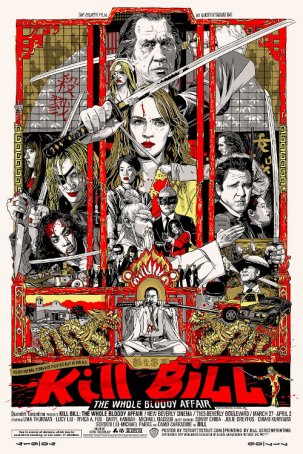
As a concept, Kill Bill has a surfeit of potential.
The problems with the film are mostly related to post-production choices, few
of which can be said to have resulted in a better product. Taken as a whole,
the movie offers its share of tremendous highs but, alongside those highs come
some unfortunate lows. The movie offers what may be the best pure action
sequence of Tarantino’s career and unquestionably the career-best performance
by lead actress Uma Thurman, but the tone is inconsistent and, even at its best,
the dialogue lacks the snap-crackle-pop quality evident in the director’s
better films.
At least three versions of Kill Bill exist (or have
at one time existed), but only one has ever been made widely available. Back in
2003, Tarantino assembled a 190-minute rough cut of a single movie that he
presented to Harvey Weinstein for consideration. Weinstein, wary of the length,
which was more than a half-hour longer than either Pulp Fiction or Jackie Brown, hatched a scheme: break the movie into two pieces, each about 90
minutes to 120 minutes in length. The carrot he dangled in front of Tarantino was
that, using this approach, many favorite “deleted scenes” could be
re-incorporated into the production. The filmmaker’s alleged wariness melted
away and he agreed wholeheartedly with the new plan. The sundering of Kill
Bill resulted in a two-volume approach that, once combined, tipped the
scales at 4 hours, 8 minutes (although, if one skips the Volume 1 end
credits, it’s possible to watch it in about 4 hours even). That’s the only
version that has ever been available either in theaters or on home video.
About 20 years ago, Tarantino teased something he called
Kill Bill: The Whole Bloody Affair. Although he assembled this cut, with
the black-and-white scenes returned to color, a small amount of additional
content added, and the entire thing re-ordered, it remained largely unavailable
to the public (excepting rare occasions when it was shown as part of
Tarantino-curated festivals and/or in his personal theater, The New Beverly
Cinema) and has never entered the home video arena.
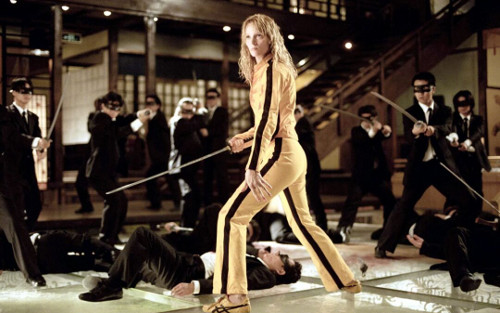 At the time of its release, my biggest gripe with Kill
Bill related to its bifurcation. Neither volume of the film stands on its
own. It’s hard to imagine anyone watching Volume 1 and not wanting to
see Volume 2 or vice versa. Did it make sense financially?
Unquestionably. The double-bill made $330M worldwide. A 190-minute single movie
would have made less than half of that. Creatively, though? Volume 1
felt incomplete and, although Volume 2 was better (in large part because
Volume 1 was already out there), it still didn’t feel like a proper
movie. Now, years later, with both
halves available, it’s possible to watch an omnibus version. And, although the
sense of incompleteness is gone, the reunification highlights other problems –
most of which have to do with pacing and directorial excess. I can’t help but
wonder whether the removal of nearly one hour’s worth of material (to arrive at
the original cut’s length) might have resulted in a movie on par with the best
of Tarantino’s oeuvre. We’ll probably never know since that version either no
longer exists or is buried so deeply in the director’s personal archives that
it will never see the light of day.
At the time of its release, my biggest gripe with Kill
Bill related to its bifurcation. Neither volume of the film stands on its
own. It’s hard to imagine anyone watching Volume 1 and not wanting to
see Volume 2 or vice versa. Did it make sense financially?
Unquestionably. The double-bill made $330M worldwide. A 190-minute single movie
would have made less than half of that. Creatively, though? Volume 1
felt incomplete and, although Volume 2 was better (in large part because
Volume 1 was already out there), it still didn’t feel like a proper
movie. Now, years later, with both
halves available, it’s possible to watch an omnibus version. And, although the
sense of incompleteness is gone, the reunification highlights other problems –
most of which have to do with pacing and directorial excess. I can’t help but
wonder whether the removal of nearly one hour’s worth of material (to arrive at
the original cut’s length) might have resulted in a movie on par with the best
of Tarantino’s oeuvre. We’ll probably never know since that version either no
longer exists or is buried so deeply in the director’s personal archives that
it will never see the light of day.
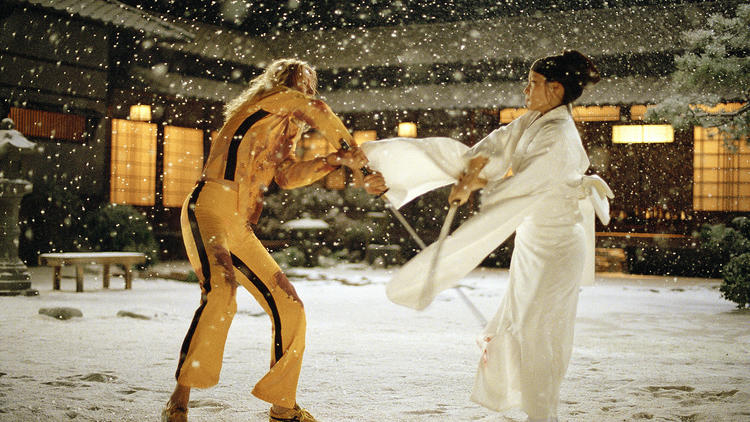 Kill Bill is a basic revenge tale that Tarantino has
dressed up by using gravity-defying martial arts and comically copious amounts
of blood. The main character initially doesn't have a name (just as she doesn't
have much of a personality - she's an icon), and during Volume 1 is
referred to solely as "The Bride" or by her code name, "Black
Mamba." In Volume 2, we learn that her real name is Beatrix Kiddo. As
played by Uma Thurman, she is grimness personified. That's understandable,
though. On her wedding day, her husband-to-be is murdered, she is beaten up and
shot in the head, and her unborn child is stolen from her womb. The responsible
parties are Bill (David Carradine) and the members of his "Deadly Viper
Assassination Squad:" O-Ren Ishii a.k.a. Cottonmouth (Lucy Liu), Vernita
Green a.k.a. Copperhead (Vivica A. Fox), Budd (Bill’s brother) a.k.a. Side
Winder (Michael Madsen), and Elle Driver a.k.a. California Mountain Snake
(Daryl Hannah). Four years later, after awakening from a coma, Beatrix has one
thing on her mind: revenge. She starts out by going after Cottonmouth and
Copperhead.
Kill Bill is a basic revenge tale that Tarantino has
dressed up by using gravity-defying martial arts and comically copious amounts
of blood. The main character initially doesn't have a name (just as she doesn't
have much of a personality - she's an icon), and during Volume 1 is
referred to solely as "The Bride" or by her code name, "Black
Mamba." In Volume 2, we learn that her real name is Beatrix Kiddo. As
played by Uma Thurman, she is grimness personified. That's understandable,
though. On her wedding day, her husband-to-be is murdered, she is beaten up and
shot in the head, and her unborn child is stolen from her womb. The responsible
parties are Bill (David Carradine) and the members of his "Deadly Viper
Assassination Squad:" O-Ren Ishii a.k.a. Cottonmouth (Lucy Liu), Vernita
Green a.k.a. Copperhead (Vivica A. Fox), Budd (Bill’s brother) a.k.a. Side
Winder (Michael Madsen), and Elle Driver a.k.a. California Mountain Snake
(Daryl Hannah). Four years later, after awakening from a coma, Beatrix has one
thing on her mind: revenge. She starts out by going after Cottonmouth and
Copperhead.
Volume 2 continues this quest for vengeance. Budd
takes longer to dispatch than Beatrix plans, but Elle goes more quickly. The
confrontation with Bill involves more talking than fighting, a choice that fits
the circumstances. About 50% of Volume 2 is used to provide backstory.
We get a lengthy flashback to events leading up to the wedding chapel massacre,
as well as a long training sequence in which Beatrix learns to become an expert
assassin under the tutelage of Pai Mei (Gordon Liu). (For those unfamiliar with
the Hong Kong flicks that serve as Tarantino's main inspiration for this
segment of the movie, think Yoda with a bad attitude.) And, as is hinted at
during the last scene of Volume 1, Beatrix gets a new role alongside
that of a blood-soaked Terminator: Mommy.
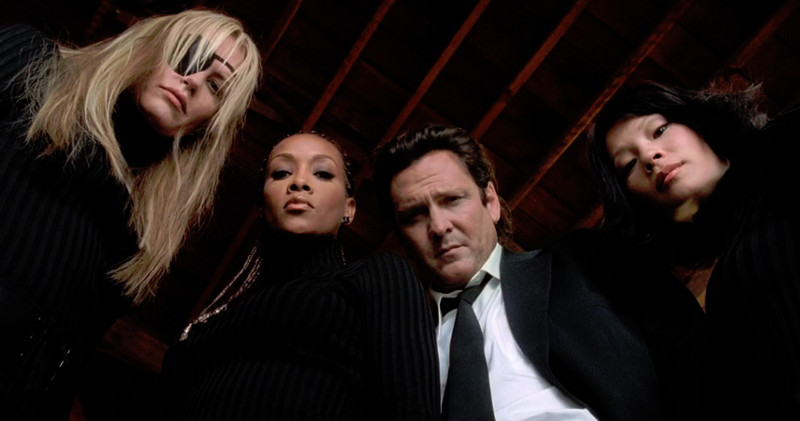 Tarantino doesn’t make happy movies and Kill Bill is
one of his darkest, although it ranks alongside Jackie Brown and Once Upon a Time…in Hollywood as having the most upbeat endings. But, in between
the opening “Klingon proverb” (“Revenge is a dish best served cold”) and the
end credits, he puts his lead character through the wringer: she is shot in the
head and left for dead, raped repeatedly while in a coma, forced to fight her
way through an army of ninjas, buried alive, and confronted with motherhood.
Tarantino doesn’t make happy movies and Kill Bill is
one of his darkest, although it ranks alongside Jackie Brown and Once Upon a Time…in Hollywood as having the most upbeat endings. But, in between
the opening “Klingon proverb” (“Revenge is a dish best served cold”) and the
end credits, he puts his lead character through the wringer: she is shot in the
head and left for dead, raped repeatedly while in a coma, forced to fight her
way through an army of ninjas, buried alive, and confronted with motherhood.
During the early years of his career, Uma Thurman was
frequently referred to as Quentin Tarantino’s muse. She was as important as
John Travolta and Samuel L. Jackson to the DNA of Pulp Fiction and she
is credited alongside Tarantino as an originator of the Bride’s character. For
Thurman, making Kill Bill wasn’t just a labor of love – it was one of
sweat and blood. Even with the aid of stunt performers and special effects
trickery, this represents an amazing feat of physicality on Thurman’s part.
And, as we get deeper into the weeds of Volume 2 and the character of
Beatrix emerges from the guise of The Bride, Thurman gets a chance to act, as
well. For his part, Tarantino allows the camera to fall in love with her,
opting for frequent close-ups, most often of her face but also of her hands and
(yes) feet. Tarantino indulges his fetish by having her barefoot for an
extended period where, slowly recovering from paralysis, she stares at her big
toe in an effort to get it to wiggle.
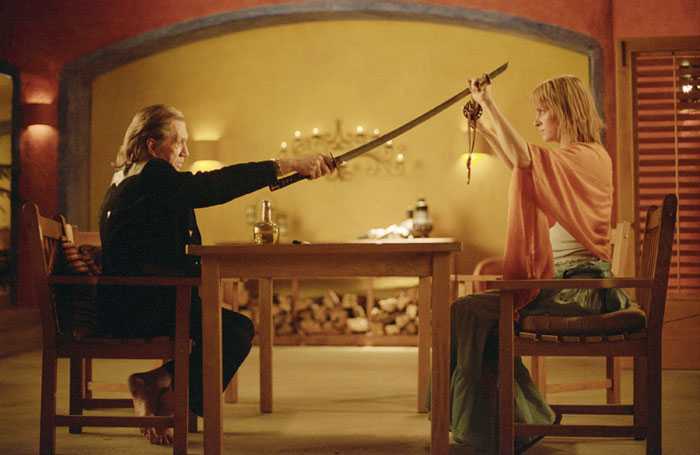 The movie is structured around five central fights and two
key flashbacks. The chronology is not straightforward, with encounter #2 (with
Vernita/Copperhead) being the first big on-screen combat, although it
chronologically follows Beatrix’s showdown with O-Ren
Ishii/Cottonmouth. The second film focuses on the entwined interactions among
Beatrix, Budd/Sidewinder, and Elle Driver/California Mountain Snake. Of the
five people on her “to kill” list, Budd is the only one Beatrix doesn’t personally
eliminate. Elle takes care of that before she gets a chance. The flashbacks,
both of which are presented in Volume 2, build Beatrix’s backstory – one
shows what happens on the day at the church and another details her training at
the hands of the un-Miyazaki-like Pai Mei.
The movie is structured around five central fights and two
key flashbacks. The chronology is not straightforward, with encounter #2 (with
Vernita/Copperhead) being the first big on-screen combat, although it
chronologically follows Beatrix’s showdown with O-Ren
Ishii/Cottonmouth. The second film focuses on the entwined interactions among
Beatrix, Budd/Sidewinder, and Elle Driver/California Mountain Snake. Of the
five people on her “to kill” list, Budd is the only one Beatrix doesn’t personally
eliminate. Elle takes care of that before she gets a chance. The flashbacks,
both of which are presented in Volume 2, build Beatrix’s backstory – one
shows what happens on the day at the church and another details her training at
the hands of the un-Miyazaki-like Pai Mei.
Most of the narrative elements surrounding Bill are
unexpected. In Volume 1, he is built up as a sort-of boogeyman. We never
see him clearly (although we hear his voice) and he comes across as an almost
godlike, indestructible force of nature. Volume 2 humanizes him,
illustrating how love (and a sense of betrayal) underly his attack on Beatrix.
The climatic encounter between the two is more of a civilized hang-out than a
fight (although there is a little of the latter). While Bill is clearly a
dangerous man, he comes across as urbane and civil – not at all how we expect
to perceive him.
One thing that has always bothered me about Kill Bill is
the somewhat cavalier way the movie traumatizes children. This is the case both
for Vernita Green’s young daughter, who is a witness to her mother’s death at
the Bride’s hands, and Beatrix’s own child, who loses the only parent she has
ever known to a woman she has just met. At the time he made Kill Bill,
Tarantino was unmarried and had no children. One wonders whether he would
change these aspects of his film today.
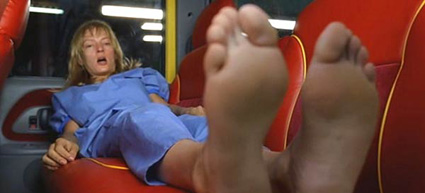 During the Battle Royale between Beatrix and O-Ren Ishii’s
army of ninjas, the Crazy 88, Tarantino appears to go into “art film director”
mode in the way he presents the carnage. Parts are in black-and-white and
others are in silhouette. In truth, these scenes are less about the director
trying to make an artistic statement than they are about bypassing MPAA
restrictions. The classification body had made it clear that if those scenes
were presented (as filmed) in full color, Kill Bill would end up with an
NC-17. However, because black-and-white was deemed less “real”, Tarantino could
get away without making cuts.
During the Battle Royale between Beatrix and O-Ren Ishii’s
army of ninjas, the Crazy 88, Tarantino appears to go into “art film director”
mode in the way he presents the carnage. Parts are in black-and-white and
others are in silhouette. In truth, these scenes are less about the director
trying to make an artistic statement than they are about bypassing MPAA
restrictions. The classification body had made it clear that if those scenes
were presented (as filmed) in full color, Kill Bill would end up with an
NC-17. However, because black-and-white was deemed less “real”, Tarantino could
get away without making cuts.
It's an enlightening experience to revisit the movie now that the whole thing is available for consumption. It’s no longer as frustrating as it was during the 2003-04 release window. However, the pacing issues are more obvious than when partially obscured by the months-long intermission. Despite narrative ties, the two movies don’t fit together seamlessly. There are instances of self-indulgence (the protracted and unnecessary anime backstory for O-Ren being an example) and times when the movie needs a stronger editor. Kill Bill contains moments that can stand alongside the best of Tarantino’s oeuvre but the film’s overlong running time and general unevenness prevent it from taking a place alongside the titles that have influenced a generation of talky, cocky, adrenaline-fueled filmmakers.
Kill Bill (United States, 2004)
Cast: Uma Thurman, Samuel L. Jackson, Bo Svenson, Sonny Chiba, Chiaki Kuriyama, Julie Dreyfus, Michael Madsen, Daryl Hannah, Lucy Liu, Vivica A. Fox, David Carradine, Gordon Liu
Home Release Date: 2025-05-01
Screenplay: Quentin Tarantino
Cinematography: Robert Richardson
Music: RZA, Robert Rodriguez
U.S. Distributor: Miramax
U.S. Home Release Date: 2025-05-01
MPAA Rating: "R" (Violence, Gore, Profanity, Feet)
Genre: Thriller
Subtitles: none
Theatrical Aspect Ratio: 2.35:1
- (There are no more better movies of Bo Svenson)
- (There are no more worst movies of Bo Svenson)
Comments